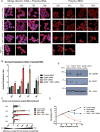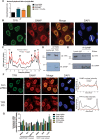Selective nuclear export of specific classes of mRNA from mammalian nuclei is promoted by GANP
- PMID: 24510098
- PMCID: PMC4005691
- DOI: 10.1093/nar/gku095
Selective nuclear export of specific classes of mRNA from mammalian nuclei is promoted by GANP
Abstract
The nuclear phase of the gene expression pathway culminates in the export of mature messenger RNAs (mRNAs) to the cytoplasm through nuclear pore complexes. GANP (germinal- centre associated nuclear protein) promotes the transfer of mRNAs bound to the transport factor NXF1 to nuclear pore complexes. Here, we demonstrate that GANP, subunit of the TRanscription-EXport-2 (TREX-2) mRNA export complex, promotes selective nuclear export of a specific subset of mRNAs whose transport depends on NXF1. Genome-wide gene expression profiling showed that half of the transcripts whose nuclear export was impaired following NXF1 depletion also showed reduced export when GANP was depleted. GANP-dependent transcripts were highly expressed, yet short-lived, and were highly enriched in those encoding central components of the gene expression machinery such as RNA synthesis and processing factors. After injection into Xenopus oocyte nuclei, representative GANP-dependent transcripts showed faster nuclear export kinetics than representative transcripts that were not influenced by GANP depletion. We propose that GANP promotes the nuclear export of specific classes of mRNAs that may facilitate rapid changes in gene expression.
Figures






Similar articles
-
Cellular NS1-BP protein interacts with the mRNA export receptor NXF1 to mediate nuclear export of influenza virus M mRNAs.J Biol Chem. 2024 Nov;300(11):107871. doi: 10.1016/j.jbc.2024.107871. Epub 2024 Oct 9. J Biol Chem. 2024. PMID: 39384042 Free PMC article.
-
mRNA export from mammalian cell nuclei is dependent on GANP.Curr Biol. 2010 Jan 12;20(1):25-31. doi: 10.1016/j.cub.2009.10.078. Epub 2009 Dec 10. Curr Biol. 2010. PMID: 20005110 Free PMC article.
-
Functional and structural characterization of the mammalian TREX-2 complex that links transcription with nuclear messenger RNA export.Nucleic Acids Res. 2012 May;40(10):4562-73. doi: 10.1093/nar/gks059. Epub 2012 Feb 4. Nucleic Acids Res. 2012. PMID: 22307388 Free PMC article.
-
The critical role of germinal center-associated nuclear protein in cell biology, immunohematology, and hematolymphoid oncogenesis.Exp Hematol. 2020 Oct;90:30-38. doi: 10.1016/j.exphem.2020.08.007. Epub 2020 Aug 20. Exp Hematol. 2020. PMID: 32827560 Review.
-
Germinal Center B-Cell-Associated Nuclear Protein (GANP) Involved in RNA Metabolism for B Cell Maturation.Adv Immunol. 2016;131:135-86. doi: 10.1016/bs.ai.2016.02.003. Epub 2016 Mar 29. Adv Immunol. 2016. PMID: 27235683 Review.
Cited by
-
Germline heterozygous mutations in Nxf1 perturb RNA metabolism and trigger thrombocytopenia and lymphopenia in mice.Blood Adv. 2020 Apr 14;4(7):1270-1283. doi: 10.1182/bloodadvances.2019001323. Blood Adv. 2020. PMID: 32236527 Free PMC article.
-
5-methylcytosine promotes mRNA export - NSUN2 as the methyltransferase and ALYREF as an m5C reader.Cell Res. 2017 May;27(5):606-625. doi: 10.1038/cr.2017.55. Epub 2017 Apr 18. Cell Res. 2017. PMID: 28418038 Free PMC article.
-
Cellular NS1-BP protein interacts with the mRNA export receptor NXF1 to mediate nuclear export of influenza virus M mRNAs.J Biol Chem. 2024 Nov;300(11):107871. doi: 10.1016/j.jbc.2024.107871. Epub 2024 Oct 9. J Biol Chem. 2024. PMID: 39384042 Free PMC article.
-
Virus Infection and mRNA Nuclear Export.Int J Mol Sci. 2023 Aug 9;24(16):12593. doi: 10.3390/ijms241612593. Int J Mol Sci. 2023. PMID: 37628773 Free PMC article. Review.
-
Nuclear pore complex acetylation regulates mRNA export and cell cycle commitment in budding yeast.EMBO J. 2022 Aug 1;41(15):e110271. doi: 10.15252/embj.2021110271. Epub 2022 Jun 23. EMBO J. 2022. PMID: 35735140 Free PMC article.
References
-
- Muller-McNicoll M, Neugebauer KM. How cells get the message: dynamic assembly and function of mRNA-protein complexes. Nat. Rev. Genet. 2013;14:275–287. - PubMed
-
- Tutucci E, Stutz F. Keeping mRNPs in check during assembly and nuclear export. Nat. Rev. Mol. Cell Biol. 2011;12:377–384. - PubMed
-
- Rodriguez-Navarro S, Hurt E. Linking gene regulation to mRNA production and export. Curr. Opin. Cell. Biol. 2011;23:302–309. - PubMed
-
- Stewart M. Nuclear export of mRNA. Trends Biochem. Sci. 2010;35:609–617. - PubMed
-
- Kohler A, Hurt E. Exporting RNA from the nucleus to the cytoplasm. Nat. Rev. Mol. Cell Biol. 2007;8:761–773. - PubMed
Publication types
MeSH terms
Substances
Associated data
- Actions
Grants and funding
LinkOut - more resources
Full Text Sources
Other Literature Sources
Molecular Biology Databases

